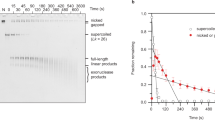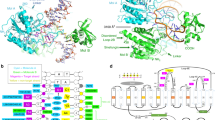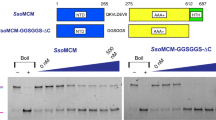Abstract
We have discovered that single-stranded DNA containing short guanine-rich motifs will self-associate at physiological salt concentrations to make four-stranded structures in which the strands run in parallel fashion. We believe these complexes are held together by guanines bonded to each other by Hoogsteen pairing. Such guanine-rich sequences occur in immunoglobulin switch regions1, in gene promoters2,3, and in chromosomal telomeres4. We speculate that this self-recognition of guanine-rich motifs of DNA serves to bring together, and to zipper up in register, the four homologous chromatids during meiosis.
This is a preview of subscription content, access via your institution
Access options
Subscribe to this journal
Receive 51 print issues and online access
$199.00 per year
only $3.90 per issue
Buy this article
- Purchase on Springer Link
- Instant access to full article PDF
Prices may be subject to local taxes which are calculated during checkout
Similar content being viewed by others
References
Shimizu, A. & Honjo, T. Cell 36, 801–803 (1984).
Evans, T., Schon, E., Gora-Maslak, G., Patterson, J. & Efstratiadis, A. Nucleic Acids Res. 12, 8043–8058 (1984).
Kilpatrick, M. W., Torri, A., Kang, D. S., Engler, J. A. & Wells, R. D. J. biol. Chem. 261, 11350–11354 (1986).
Blackburn, E. H. & Szostak, J. W. A. Rev. Biochem. 53, 163–194 (1984).
Nikaido, T., Yamawaki-Kataoka, Y. & Honjo, T. J. biol. Chem. 257, 7322–7329 (1982).
Maxam, A. & Gilbert, W. Meth. Enzym. 65, 499–560 (1977).
Hoogsteen, K. Acta Crystallogr. 12, 822–823 (1959).
Arnott, S., Chandrasekaran, R. & Marttila, C. M. Biochem. J. 141, 537–543 (1974).
Zimmerman, S. B., Cohen, G. H. & Davis, D. R. J. molec. Biol. 92, 181–192 (1975).
John, B. Chromosoma 54, 295–325 (1976).
Maguire, M. P. J. theor. Biol. 106, 605–615 (1984).
Ashley, T. & Wagenaar, E. B. Can. J. Genet. Cytol. 16, 61–76 (1974).
Gillies, C. B. Trav. Lab. Carlsberg 40, 135 (1975).
Holm, P. B. Trav. Lab. Carlsberg 42, 103 (1977).
Weiner, A. M. Cell 52, 155–157 (1988).
Henderson, E., Hardin, C. C., Walk, S. K., Tinoco, I. & Blackburn, E. H. Cell 51, 899–908 (1987).
Oka, Y. & Thomas, C. A. Nucleic Acids Res. 15, 8877–8898 (1987).
Mirkin, S. M. et al. Nature 330, 495–497 (1987).
Hotta, Y. & Stern, H. J. molec. Biol. 55, 337–355 (1971).
Moens, P. B. Cold Spring Harb. quant. Symp. 49, 699–705 (1984).
Author information
Authors and Affiliations
Rights and permissions
About this article
Cite this article
Sen, D., Gilbert, W. Formation of parallel four-stranded complexes by guanine-rich motifs in DNA and its implications for meiosis. Nature 334, 364–366 (1988). https://doi.org/10.1038/334364a0
Received:
Accepted:
Published:
Issue Date:
DOI: https://doi.org/10.1038/334364a0
This article is cited by
-
TMPRSS2 isoform 1 downregulation by G-quadruplex stabilization induces SARS-CoV-2 replication arrest
BMC Biology (2024)
-
G-quadruplexes promote the motility in MAZ phase-separated condensates to activate CCND1 expression and contribute to hepatocarcinogenesis
Nature Communications (2024)
-
Stress promotes RNA G-quadruplex folding in human cells
Nature Communications (2023)
-
ALS-linked TDP-43 mutations interfere with the recruitment of RNA recognition motifs to G-quadruplex RNA
Scientific Reports (2023)
-
G4Bank: A database of experimentally identified DNA G-quadruplex sequences
Interdisciplinary Sciences: Computational Life Sciences (2023)
Comments
By submitting a comment you agree to abide by our Terms and Community Guidelines. If you find something abusive or that does not comply with our terms or guidelines please flag it as inappropriate.



